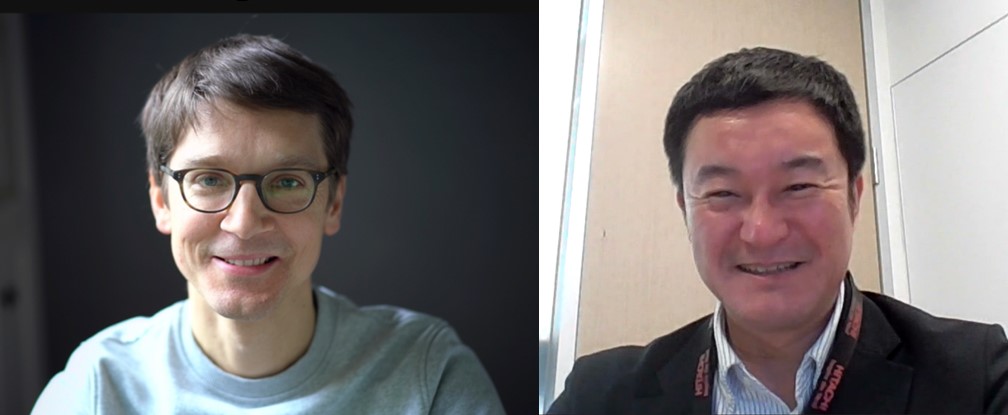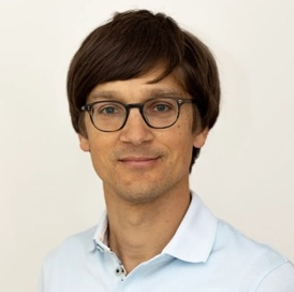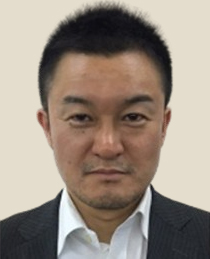
An interview with Jure Leskovec, Professor of Computer Science at Stanford University
By Nishio Yamada, Vice President and Head of the Financial Innovation Lab, Hitachi America R&D
I’m delighted to introduce Prof. Jure Leskovec to our global audience. As Professor of Computer Science at Stanford University, former Chief Scientist at Pinterest, co-founder of two startups, and builder of developer communities, Jure has traversed academia and business for over two decades. His focus throughout? Relationships. Using his renowned expertise in graph learning, a form of machine learning used to analyze graph-based data, Jure has tackled “real world” issues from socioeconomic segregation and relationships on social media, to the workings of supply chains, banking transactions and DNA sequences. Jure’s inquisitiveness and originality are boundless. His community-building and views on innovation speak volumes about his generosity. I’m certain you’ll find Jure’s work inspiring, as well as instructive. Also, special thanks to my colleague Qi Xiu at Hitachi America R&D for working closely with Jure and making this interview happen. This interview has been edited for conciseness and clarity.

Nishio: Thanks so much for joining us today, Jure. You’ve had an amazing career thus far, in academia as well as in business. What drives everything you do?
Jure: Thank you for having me. In essence, I study relationships-what we call “relational domains.” If I want to get data about a person or entity, I look at their interactions and at the interactions of those interactions. In my early research, I examined relationships among people on social media platforms, but the scope of my research has expanded over the years.
What’s been consistent, though, is that I’ve always liked my research to have real-world impact: to advance discoveries that change our understanding of things. An example of this kind of research, which happens to be in social science, is a paper we just published in Nature on the question of socioeconomic segregation.
We assume that people in cities interact with a vast array of people, socioeconomically. If you live in a diverse neighborhood, you have diverse interactions, right? Not necessarily so.
We looked at this problem by analyzing some 1.6 billion interactions among cell phone users, and we discovered that people in cities tend to interact with people who have similar socioeconomic backgrounds, whereas people in small towns tend to have more diverse interactions. This is because people in cities frequent an array of establishments and institutions. For example, in New York, there are thousands of restaurants, so people can choose to go to the ones where they feel like they “belong.” They gravitate toward places where they can be with people like themselves. On the other hand, people in small towns only have a few places where they can congregate, so you have people from different backgrounds coming together.
I found this discovery fascinating. It upended our ideas about segregation, and it was all thanks to big data analysis enabled by computer science.
In the public health space, we did some very meaningful research around COVID. We were the first to show how much staying at home helped prevent the spread of the virus. Using GPS data from cell phones, we demonstrated the best method to reopen economies. Our paper had a worldwide impact. The Japanese government used our work to set guidelines for reopening their economy.
I like working with businesses to understand real world problems. We in academia find ways to collaborate with partners in industry and try to understand what their key concerns are. Universities can come in and say, “Let's do some research to find out what your concerns are and together develop the best ways to solve them.” Businesses cannot do this so easily because they have limited time, and they have customers and shareholders to serve.
My motivation has always been to discover the truth that’s instilled in our universe. I’m the type of person who gets very excited but also gets bored [easily]. I like to think about what the next thing is.
Nishio: Your method of discovery is “graph neural networks.” Since neural networks are still a relatively new concept to a business audience, could you explain briefly what they are and their applications in an industrial context?
Jure: Sure. Put simply, neural networks are algorithms that mimic how the brain works. They include layers of nodes, or neurons, millions of them, that process data. They can learn from their mistakes, keep learning and improving. Neural networks are at the core of machine learning.
Traditionally, neural networks were applied to image data, which is fixed. Image data is basically a grid of pixels, so they’re relatively easy to work with. Think computer vision. Increases in graphics processing power, or GPUs, over the years have enabled us to process image data more efficiently.
What has happened more recently is that we’ve figured out how to train very deep neural networks beyond images. Now we can train them on linear sequences, sequences of characters, and even human language. This is how large language models and ChatGPT emerged.
But what’s exciting is that we don’t have to stop at language. We can choose to apply neural networks to, say, a DNA sequence, and use this to understand biology.
Graph neural networks allow you to apply the power of neural networks to a more general data type, such as business data. A graph may seem like an esoteric mathematical construct, but they are used more often than you think. A large amount of business data is represented in the form of graphs, which are stored in relational databases and data warehouses. What we’re talking about now is not only natural language. We’re talking about transactions, relationships, entities, products, customers, and behaviors. If it’s stored in a data warehouse or in a database, you can apply graph learning to it.
Nishio: And your expertise in graph learning led you to launch two startups, Kosei and Kumo.ai.
Jure: Kosei was an ads startup which used a product graph and machine learning to map out relationships and match mobile advertisers to customers. It was acquired by Pinterest. I then joined Pinterest as a Chief Scientist for six years.
At Pinterest, I wanted to address the “discovery problem”: to guide people towards things they didn’t know they were looking for, or only had a vague idea of. We had written a paper at Stanford called GraphSAGE, which now has 3,000 citations. That was a paper about how you apply neural networks to graphs.
The student who developed it came to Pinterest and we built a team around the idea. We took all the entities-the users, the images, the search queries, the advertisers-and we mapped them out in what’s called a “common embedding space.” So you could answer the question: “What’s the best Pin for this query?” GraphSAGE was further developed into the PinSage algorithm, which addressed the specific needs of Pinterest.
We built out Pinterest’s AI and ML platforms. It took a big investment and four years to build. We were fortunate that leadership was willing to make that investment, and that we were ultimately able to deliver.
The technology transformed Pinterest, providing much more accurate AI for user recommendations. It led to a 30 to 50 percent growth in core metrics and contributed to the company going public because its performance and business metrics improved so much.
Of course, many companies tried to replicate our tool. Amazon implemented similar technologies with great success, as well as Uber, Spotify, and a few others. But the technology is very challenging to incorporate. It was only implemented by the best Silicon Valley companies, though for everyone else, it was out of reach.
Nishio: And now you’re working on Kumo.ai and getting a lot of attention from large companies. Why?
Jure: I’ve been working on Kumo.ai for the past three years. Kumo is a graph learning platform. You don’t need a high-powered Silicon Valley team to access it, so we’re excited about that. By the way, as you know, “kumo” is a Japanese word. It means “cloud” and also “spider.” I think it’s a beautiful name.
As for the technology, it’s a neural network that weaves your data in the “cloud” like a “spider” and builds AI on top of it. We are using the power of deep neural networks and graph neural networks to enable high-performance tasks. It delivers domain-specific AI on private data. We create predictive analytics from enterprise data.
Nishio: You’ve hit on something that many industrial companies are working on, and that’s “domain-specific AI.” Tell us more.
Jure: While we’re all excited about large language models, they are a generic model, trained on public data. That’s a problem for companies that need to differentiate, which all companies do. They want to be unique.
What you want is task-specific AI that is trained on your own tasks and on your own data. Hitachi does things differently from other companies, so why would you want to replicate the same decisions as other businesses? You want to make decisions specific to your needs, data, processes, and culture. With this technology, you can build AI that is both domain and task specific.
Nishio: Could you share examples of industrial applications of graph neural networks?
Jure: As you know, we’ve worked with Hitachi on supply chains. The supply chain is essentially a graph of relationships. Businesses are sending products to one another. You can model this as a giant network of goods being passed around, and you can start analyzing for bottlenecks, reconfigurations, and optimizations. You can also identify slowdowns and inefficiencies. The challenge with supply chains is that so much data is hidden. I think the more historic data you can access, the better.
Businesses need AI to help forecast how much a customer is going to order, and when, or even whether customers are likely to withdraw their business. On the supply side, they can start forecasting who's going to be early and who's going to be late.
We’ve done a lot of work with financial transactions. At Kumo, we are working with banks and we see amazing results: for instance, a 45 percent increase in fraud detection.
Nishio: Communities are key to building out these platforms. What’s your vision for communities? I’m referring, of course, to PyG and Open Graph Benchmark.
Jure: Community building is important because it lowers barriers to entry and empowers others. It disseminates and democratizes technology. With this in mind, we launched the Open Graph Benchmark, which has been very successful.
We then launched PyG, which is the most popular open-source graph neural network tool kit in the world. We have an annual conference every year at Stanford attended by 7,000 people around the world, in-person and virtually. I also make all my classes available on YouTube. They have over one million views.
This requires additional work, but again, it’s about disseminating and democratizing knowledge. The idea is: let's just give it away for free, so everyone can progress and excel and grow in their own areas. It’s a way for me to allow people throughout the world to benefit.
I was born in Slovenia, a country of two million people, but I was able to learn and grow. I'd like others to enjoy the same benefits I did.
Nishio: At Hitachi, we’re committed to being open and participating in the Silicon Valley ecosystem, which of course includes Stanford, to fuel our innovation and growth as well as to benefit society. What’s essential for large organizations to truly benefit from working with the ecosystem?
Jure: Innovation is a group activity, right? To your point, it’s all about the ecosystem: universities, education, companies. It’s about taking risks. Individuals, or organizations, cannot innovate in isolation. Scientists know this, which is why we publish, go to conferences, read each other’s work, and try to learn from each other. We know we have to be plugged in. That’s part of the innovation cycle.
Innovation in company settings, however, inevitably involves managing risk. You have customers. You have shareholders. So you have to innovate in a way where you have the right balance between risk and reward. Innovation can’t be too costly, but it can’t be totally devoid of negative consequences either.
Big companies can fuel innovation by looking outward and empowering smaller, more nimble teams to take ownership of their projects. Innovation is not a top-down process, and it’s not a deliberate process, in the sense that some boss could ever decide the winner. You have to foster a spirit of openness and learning, a culture where leaders allow themselves to be proven wrong.
I want my employees and my students to feel empowered to say, “Hey, he’s thinking this, but I’m going to try this other thing as well.” I wouldn’t tell them, “You’re [being] defiant. You’re not doing what I tell you.”
As a professor and as a Chief Scientist, I require proof, of course, but I couldn't be happier if somebody proves me wrong. Because then I'm like, “Okay, where was my intuition wrong? How do I learn from this?”
Nishio: With that in mind: who decides what has potential and what to invest resources in?
Jure: The point of innovation is that nature, the earth, the universe, decides the winner. So in that respect, for innovation, you need diversity of ideas, and you need to let that diversity of ideas flourish and then see which ones really take root. You cannot choose a winner prematurely.
Successful innovation means creating an environment where you have enough diversity that whatever happens, there’s already a winner among us. If we have diversity among companies, then surely one of them will be ready for what's happening tomorrow.
That's the benefit of Silicon Valley as an ecosystem, this immense diversity. So if tomorrow, say, hydro energy ends up being the important thing, I'm sure there are already companies doing innovative things in that field.
Of course, as humans, we are kicking and screaming for the universe not to decide the winner! But on a global level, it’s suboptimal to choose the winner. The winner has to emerge. The universe chooses who or what that will be.
Nishio: In closing, what concerns do you have? What obstacles to innovation and success do you see? What keeps you up at night?
Jure: Very little, actually. I sleep extremely well! I think these are exciting times in the tech industry. If anything, what prevents me from sleeping is the excitement I feel every day.
###

Jure Leskovec
Computer Science Professor
Stanford University
Jure Leskovec is Professor of Computer Science at Stanford University. He is affiliated with the Stanford AI Lab, Machine Learning Group and the Center for Research on Foundation Models. In the past, he served as a Chief Scientist at Pinterest and was an investigator at Chan Zuckerberg BioHub. Leskovec recently pioneered the field of Graph Neural Networks and co-authored PyG, the most widely-used graph neural network library. Research from his group has been used by many countries to fight the COVID-19 pandemic, and has been incorporated into products at Facebook, Pinterest, Uber, YouTube, Amazon, and more.
His research received several awards including the Microsoft Research Faculty Fellowship in 2011, Okawa Research award in 2012, Alfred P. Sloan Fellowship in 2012, Lagrange Prize in 2015, and the ICDM Research Contributions Award in 2019. His research contributions have spanned social networks, data mining and machine learning, and computational biomedicine with the focus on drug discovery. His work has won 12 best paper awards and 5 10-year test of time awards at premier forums in these research areas.
Leskovec received his bachelor's degree in computer science from University of Ljubljana, Slovenia, PhD in machine learning from Carnegie Mellon University and postdoctoral training at Cornell University.

Nishio Yamada
Vice President and Head of the Financial Innovation Lab
R&D Division
Hitachi America, Ltd.
Nishio Yamada is Vice President and Head of the Financial Innovation Lab at Hitachi America R&D. Nishio has been with Hitachi for over 20 years, joining the Systems Development Laboratory in 2002. His expertise includes system architectures, business process modeling and social infrastructure systems. Nishio has led mission critical development projects focused on core banking and insurance policy management systems for major Japanese financial institutions as well as innovative development projects leveraging blockchain and NFT. In 2020, Nishio was appointed Manager of Hitachi’s Societal Systems Research Lab. Joining Hitachi America R&D in 2022, he is currently leading co-creation projects to incubate cross-sector financial solutions and services for the US financial market.
Nishio earned his master’s degree in computer science from Kyoto University in Japan and is currently working on his PhD from Kyoto University.